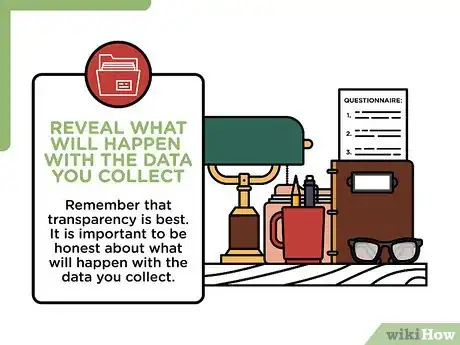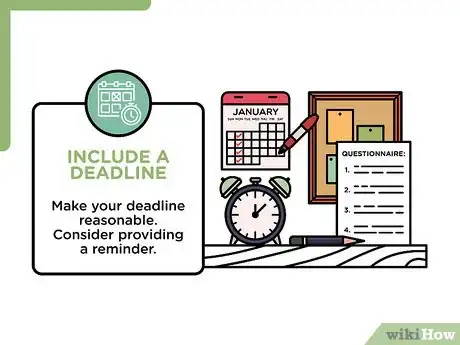wikiHow is a “wiki,” similar to Wikipedia, which means that many of our articles are co-written by multiple authors. To create this article, 24 people, some anonymous, worked to edit and improve it over time.
There are 13 references cited in this article, which can be found at the bottom of the page.
wikiHow marks an article as reader-approved once it receives enough positive feedback. This article received 41 testimonials and 92% of readers who voted found it helpful, earning it our reader-approved status.
This article has been viewed 561,587 times.
Learn more...
A questionnaire is a technique for collecting data in which a respondent provides answers to a series of questions.[1] To develop a questionnaire that will collect the data you want takes effort and time. However, by taking a step-by-step approach to questionnaire development, you can come up with an effective means to collect data that will answer your unique research question.
Steps
Designing Your Questionnaire
-
1Identify the goal of your questionnaire. What kind of information do you want to gather with your questionnaire? What is your main objective? Is a questionnaire the best way to go about collecting this information?
- Come up with a research question. It can be one question or several, but this should be the focal point of your questionnaire.
- Develop one or several hypotheses that you want to test. The questions that you include on your questionnaire should be aimed at systematically testing these hypotheses.
-
2Choose your question type or types. Depending on the information you wish to gather, there are several possible types of questions to include on your questionnaire, each with unique pros and cons. Here are the types of commonly used questions on a questionnaire:
- Dichotomous question: this is a question that will generally be a “yes/no” question, but may also be an “agree/disagree” question. It is the quickest and simplest question to analyze, but is not a highly sensitive measure.
- Open-ended questions: these questions allow the respondent to respond in their own words. They can be useful for gaining insight into the feelings of the respondent, but can be a challenge when it comes to analysis of data. It is recommended to use open-ended questions to address the issue of “why.”[2]
- Multiple choice questions: these questions consist of three or more mutually-exclusive categories and ask for a single answer or several answers.[3] Multiple choice questions allow for easy analysis of results, but may not give the respondent the answer they want.
- Rank-order (or ordinal) scale questions: this type of question asks your respondent to rank items or choose items in a particular order from a set. For example, it might ask your respondents to order five things from least to most important. These types of questions forces discrimination among alternatives, but does not address the issue of why the respondent made these discriminations.[4]
- Rating scale questions: these questions allow the respondent to assess a particular issue based on a given dimension. You can provide a scale that gives an equal number of positive and negative choices, for example, ranging from “strongly agree” to “strongly disagree.”[5] These questions are very flexible, but also do not answer the question “why.”
Advertisement -
3Develop questions for your questionnaire. The questions that you develop for your questionnaire should be clear, concise, and direct. This will ensure that you get the best possible answers from your respondents.
- Write questions that are succinct and simple. You should not be writing complex statements or using technical jargon, as it will only confuse your respondents and lead to incorrect responses.
- Ask only one question at a time. This will help avoid confusion
- Beware of asking for private or “sensitive” information.[6]
This can be something as simple as age or weight, or something as complex as past sexual history.
- Asking questions such as these usually require you to anonymize or encrypt the demographic data you collect.
- Determine if you will include an answer such as “I don’t know” or “Not applicable to me.” While these can give your respondents a way of not answering certain questions, providing these options can also lead to missing data, which can be problematic during data analysis.
- Put the most important questions at the beginning of your questionnaire.[7] This can help you gather important data even if you sense that your respondents may be becoming distracted by the end of the questionnaire.
-
4Restrict the length of your questionnaire. Keep your questionnaire as short as possible. More people will be likely to answer a shorter questionnaire, so make sure you keep it as concise as possible while still collecting the necessary information.[8] If you can make a questionnaire that only requires 5 questions, do it.
- Only include questions that are directly useful to your research question.[9] A questionnaire is not an opportunity to collect all kinds of information about your respondents.
- Avoid asking redundant questions. This will frustrate those who are taking your questionnaire.
-
5Identify your target demographic. Is there a certain group of people who you want to target with your questionnaire? If so, it is best to determine this before you begin to distribute your questionnaire.[10]
- Consider if you want your questionnaire to collect information from both men and women. Some studies will only survey one sex.
- Determine whether you want your survey to collect information from both children and adults. Many surveys only target certain age ranges for which the questions are applicable.
- Consider including a range of ages in your target demographic. For example, you can consider young adult to be 18-29 years old, adults to be 30-54 years old, and mature adults to be 55+. Providing the an age range will help you get more respondents than limiting yourself to a specific age.
- Consider what else would make a person a target for your questionnaire. Do they need to drive a car? Do they need to have health insurance? Do they need to have a child under 3? Make sure you are very clear about this before you distribute your questionnaire.
-
6Ensure you can protect privacy. Make your plan to protect respondents’ privacy before you begin writing your survey. This is a very important part of many research projects.
- Consider an anonymous questionnaire. You may not want to ask for names on your questionnaire. This is one step you can take to prevent privacy, however it is often possible to figure out a respondent’s identity using other demographic information (such as age, physical features, or zipcode).
- Consider de-identifying the identity of your respondents. Give each questionnaire (and thus, each respondent) a unique number or word, and only refer to them using that new identifier. Shred any personal information that can be used to determine identity.
- Remember that you do not need to collect much demographic information to be able to identify someone. People may be wary to provide this information, so you may get more respondents by asking less demographic questions (if it is possible for your questionnaire).
- Make sure you destroy all identifying information after your study is complete.
Writing your questionnaire
-
1Introduce yourself. Your introduction should explain who you are, and what your credentials are. You should clarify if you are working alone or as a part of a team. Include the name of the academic institution or company for whom you are collecting data. Here are some examples:
- My name is Jack Smith and I am one of the creators of this questionnaire. I am part of the Department of Psychology at the University of Michigan, where I am focusing in developing cognition in infants.
- I’m Kelly Smith, a 3rd year undergraduate student at the University of New Mexico. This questionnaire is part of my final exam in statistics.
- My name is Steve Johnson, and I’m a marketing analyst for The Best Company. I’ve been working on questionnaire development to determine attitudes surrounding drug use in Canada for several years.
-
2Explain the purpose of the questionnaire.[11] Many people will not answer a questionnaire without understanding what the goal of the questionnaire is. No long explanation is needed; instead, a few concise sentences will do the trick. Here are some examples:
- I am collecting data regarding the attitudes surrounding gun control. This information is being collected for my Anthropology 101 class at the University of Maryland.
- This questionnaire will ask you 15 questions about your eating and exercise habits. We are attempting to make a correlation between healthy eating, frequency of exercise, and incidence of cancer in mature adults.
- This questionnaire will ask you about your recent experiences with international air travel. There will be three sections of questions that will ask you to recount your recent trips and your feelings surrounding these trips, as well as your travel plans for the future. We are looking to understand how a person’s feelings surrounding air travel impact their future plans.
-
3Reveal what will happen with the data you collect. Are you collecting these data for a class project, or for a publication? Are these data to be used for market research? Depending on what you intend to do with the data you collect from your questionnaire, there may be different requirements that you need to pay attention to before distributing your survey.
- Beware that if you are collecting information for a university or for publication, you may need to check in with your institution’s Institutional Review Board (IRB) for permission before beginning. Most research universities have a dedicated IRB staff, and their information can usually be found on the school’s website.
- Remember that transparency is best. It is important to be honest about what will happen with the data you collect.
- Include an informed consent for if necessary. Note that you cannot guarantee confidentiality, but you will make all reasonable attempts to ensure that you protect their information.[12]
-
4Estimate how long the questionnaire will take. Before someone sits down to take your questionnaire, it may be helpful for them to know whether the questionnaire will take them 10 minutes or 2 hours. Providing this information at the onset of your questionnaire is more likely to get you more complete questionnaires in the end.
- Time yourself taking the survey. Then consider that it will take some people longer than you, and some people less time than you.
- Provide a time range instead of a specific time. For example, it’s better to say that a survey will take between 15 and 30 minutes than to say it will take 15 minutes and have some respondents quit halfway through.
- Use this as a reason to keep your survey concise! You will feel much better asking people to take a 20 minute survey than you will asking them to take a 3 hour one.
-
5Describe any incentives that may be involved. An incentive is anything that you can offer as a reward at the end of the questionnaire. Incentives can be many types of things: they can be monetary, desired prizes, gift certificates, candy, etc. There are both pros and cons to offering incentives.
- Incentives can attract the wrong kind of respondent. You don’t want to incorporate responses from people who rush through your questionnaire just to get the reward at the end. This is a danger of offering an incentive.[13]
- Incentives can encourage people to respond to your survey who might not have responded without a reward. This is a situation in which incentives can help you reach your target number of respondents.[14]
- Consider the strategy used by SurveyMonkey. Instead of directly paying respondents to take their surveys, they offer 50 cents to the charity of their choice when a respondent fills out a survey. They feel that this lessens the chances that a respondent will fill out a questionnaire out of pure self-interest.[15]
- Consider entering each respondent in to a drawing for a prize if they complete the questionnaire. You can offer a 25$ gift card to a restaurant, or a new iPod, or a ticket to a movie. This makes it less tempting just to respond to your questionnaire for the incentive alone, but still offers the chance of a pleasant reward.
-
6Make sure your questionnaire looks professional. Because you want people to have confidence in you as a data collector, your questionnaire must have a professional look.
- Always proof read. Check for spelling, grammar, and punctuation errors.
- Include a title. This is a good way for your respondents to understand the focus of the survey as quickly as possible.
- Thank your respondents. Thank them for taking the time and effort to complete your survey.
Distributing Your Questionnaire
-
1Do a pilot study. Ask some people you know to take your questionnaire (they will not be included in any results stemming from this questionnaire), and be prepared to revise it if necessary.[16] Plan to include 5-10 people in the pilot testing of your questionnaire.[17] Get their feedback on your questionnaire by asking the following questions:
- Was the questionnaire easy to understand? Were there any questions that confused you?
- Was the questionnaire easy to access? (Especially important if your questionnaire is online).
- Do you feel the questionnaire was worth your time?
- Were you comfortable answering the questions asked?
- Are there any improvements you would make to the questionnaire?
-
2Disseminate your questionnaire. You need to determine what is the best way to disseminate your questionnaire.[18] There are several common ways to distribute questionnaires:
- Use an online site, such as SurveyMonkey.com. This site allows you to write your own questionnaire with their survey builder, and provides additional options such as the option to buy a target audience and use their analytics to analyze your data.[19]
- Consider using the mail. If you mail your survey, always make sure you include a self-addressed stamped envelope so that the respondent can easily mail their responses back. Make sure that your questionnaire will fit inside a standard business envelope.
- Conduct face-to-face interviews. This can be a good way to ensure that you are reaching your target demographic and can reduce missing information in your questionnaires, as it is more difficult for a respondent to avoid answering a question when you ask it directly.
- Try using the telephone. While this can be a more time-effective way to collect your data, it can be difficult to get people to respond to telephone questionnaires.
-
3Include a deadline. Ask your respondents to have the questionnaire completed and returned to you by a certain date to ensure that you have enough time to analyze the results.
- Make your deadline reasonable. Giving respondents up to 2 weeks to answer should be more than sufficient. Anything longer and you risk your respondents forgetting about your questionnaire.
- Consider providing a reminder. A week before the deadline is a good time to provide a gentle reminder about returning the questionnaire. Include a replacement of the questionnaire in case it has been misplaced by your respondent.[20]
Community Q&A
-
QuestionHow can I develop a questionnaire involving children?
 Community AnswerQuestions need to be direct and simple. Keep the number of questions low since children get easily distracted and have limited attention spans.
Community AnswerQuestions need to be direct and simple. Keep the number of questions low since children get easily distracted and have limited attention spans. -
QuestionHow do I develop a questionnaire for integration of drawing with geometry?
 Community AnswerThink of questions that give you the conclusions you need, and make sure people can only answer "yes" or "no."
Community AnswerThink of questions that give you the conclusions you need, and make sure people can only answer "yes" or "no." -
QuestionWhat design considerations should be included when creating a questionnaire?
 Community AnswerIf you want to generate comparable data, use true/false questions, multiple choice, or numerical scales. To gather more detail, use open-ended questions. When wording the questions, consider the age range, cultural background, and educational level of your intended participants.
Community AnswerIf you want to generate comparable data, use true/false questions, multiple choice, or numerical scales. To gather more detail, use open-ended questions. When wording the questions, consider the age range, cultural background, and educational level of your intended participants.
References
- ↑ https://www.questionpro.com/blog/what-is-a-questionnaire/
- ↑ https://www.hotjar.com/blog/open-ended-questions/
- ↑ https://www.questionpro.com/a/showArticle.do?articleID=survey-questions
- ↑ https://surveysparrow.com/blog/ranking-questions-examples/
- ↑ https://www.lumoa.me/blog/rating-scale/
- ↑ http://www.sciencebuddies.org/science-fair-projects/project_ideas/Soc_survey.shtml
- ↑ http://www.monash.edu.au/lls/hdr/design/2.4.3.html
- ↑ http://www.sciencebuddies.org/science-fair-projects/project_ideas/Soc_survey.shtml
- ↑ http://www.fao.org/docrep/W3241E/w3241e05.htm
- ↑ http://www.fao.org/docrep/W3241E/w3241e05.htm
- ↑ http://managementhelp.org/businessresearch/questionaires.htm
- ↑ http://managementhelp.org/businessresearch/questionaires.htm
- ↑ https://www.surveymonkey.com/mp/survey-rewards/
- ↑ https://www.surveymonkey.com/mp/survey-rewards/
- ↑ https://www.surveymonkey.com/mp/survey-rewards/
- ↑ http://www.fao.org/docrep/W3241E/w3241e05.htm
- ↑ http://www.sciencebuddies.org/science-fair-projects/project_ideas/Soc_survey.shtml
- ↑ http://www.ideafit.com/fitness-library/how-to-develop-a-questionnaire
- ↑ https://www.surveymonkey.com/mp/take-a-tour/?ut_source=header
- ↑ http://www.monash.edu.au/lls/hdr/design/2.4.3.html
About This Article
To develop a questionnaire for research, identify the main objective of your research to act as the focal point for the questionnaire. Then, choose the type of questions that you want to include, and come up with succinct, straightforward questions to gather the information that you need to answer your questions. Keep your questionnaire as short as possible, and identify a target demographic who you would like to answer the questions. Remember to make the questionnaires as anonymous as possible to protect the integrity of the person answering the questions! For tips on writing out your questions and distributing the questionnaire, keep reading!




















-Step-17.webp)























































